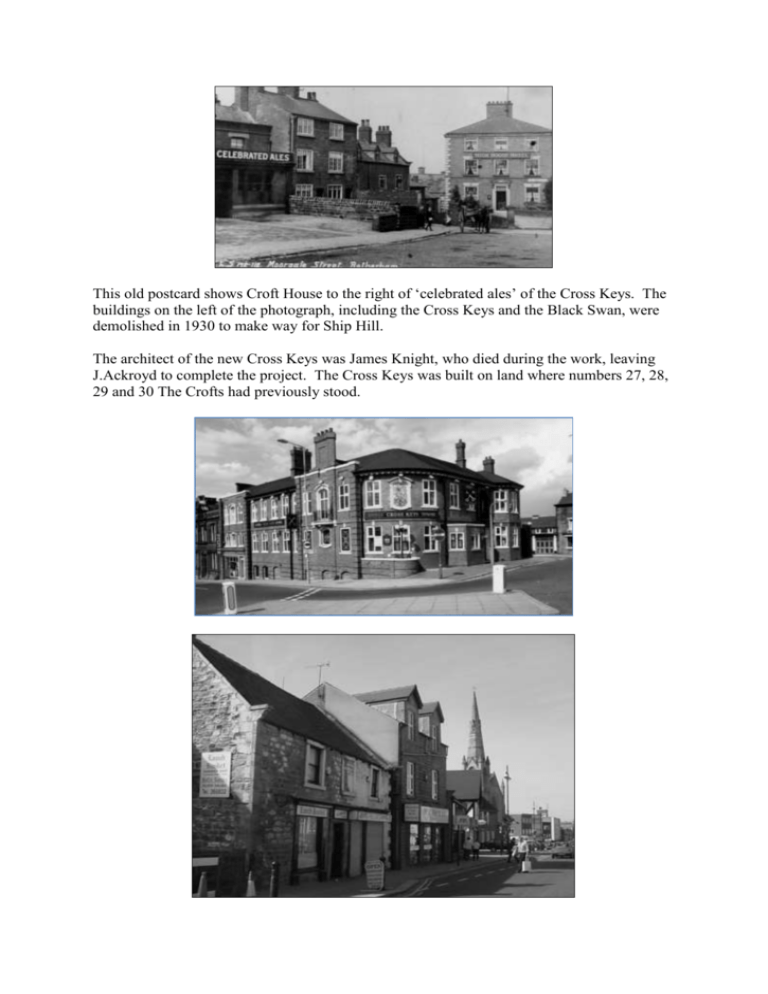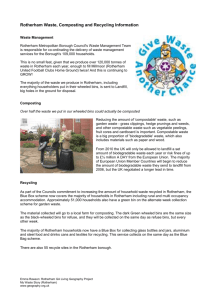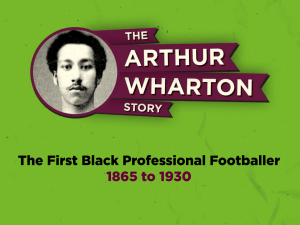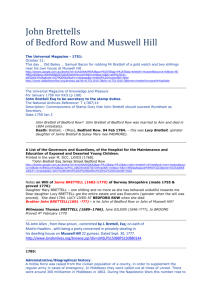The Crofts and Cattle Market - Rotherham District Civic Society
advertisement

This old postcard shows Croft House to the right of ‘celebrated ales’ of the Cross Keys. The buildings on the left of the photograph, including the Cross Keys and the Black Swan, were demolished in 1930 to make way for Ship Hill. The architect of the new Cross Keys was James Knight, who died during the work, leaving J.Ackroyd to complete the project. The Cross Keys was built on land where numbers 27, 28, 29 and 30 The Crofts had previously stood. The Downs Row Chapel Henry Braithwaite, who was the schoolmaster in 1861, 1871 and 1881, was born in Moorsom in 1814. He married Jane Runton and moved to Rotherham in 1850 after having lived in Bradford and Huddersfield. He was also Clerk to the Burial Board at a time when the parish churchyard was being closed and the cemetery on Moorgate being purchased and developed. 21 (10) Henry Parkin Badger (1823 – 1864) Henry Parkin Badger was born on the 18th October 1823 and was the second son of Thomas Badger. As a young man he was in business as a merchant in Sheffield but on the death of his younger brother, Walter, he joined his father and was admitted as a solicitor in 1853. He was already living on the Crofts in 1851, when he was described as a solicitor’s articled clerk. He lived there with his wife, children and two servants. He was still on the Crofts in 1861 and increasing affluence as a solicitor meant that he was able to employ four servants. He moved into his dead fathers’ house on High Street in 1862. He was Deputy Coroner and attended to the conveyancing and general practice of his firm and to the development of the family property. He died on 22nd April 1864 at the age of forty and he was buried in Moorgate Cemetery. Fortunately, he was not alive to hear about the scandal caused by his son, Thomas Wright Badger. Thomas used some of the family fortune to build the Red House at Sitwell Vale. He then ran up debts and contracted a marriage he wasn’t happy with and ran off to France, leaving his partner, Frederick Rhodes, to pick up the pieces. 1841 James Yates, born 1801, an iron master. James lost a son in the Masbrough Boat Disaster in this year. The success of his partnership with George Haywood in a stove grate works led him to build Oakwood Hall on Moorgate. Number 21 Number 23 (12) 1841 and 1851 Jacob Brettell was born at Sutton-in-Ashfield, Nottinghamshire, on 16 April 1793. His grandfather was an independent minister at Wolverhampton, and afterwards assistant to James Wheatley at the Norwich Calvinistic methodist tabernacle. His father, Jacob Brettell, became a Calvinistic preacher at the age of seventeen, and after serving various chapels became an independent minister at Sutton-in-Ashfield in 1788. Here he renounced Calvinism, and in 1791 opened a separate meeting-house. In 1795 he became assistant to Jeremiah Gill, minister of the 'presbyterian or independent' congregation at Gainsborough, and on Gill's death, 1796, he became sole minister. He also kept a school (see notice by a pupil, E. S. Peacock, in Notes and Queries, 2nd series, xi. 378). He died 19 March 1810. His only son, Jacob, had been placed at Manchester College, York, in 1809. A public subscription, aided by the vicar of Gainsborough, provided for his continuance at York till 1814. He became Unitarian minister at Cockey Moor (now called Ainsworth), Lancashire, in July 1814, and removed to Rotherham in September 1816. He resigned in June 1859 from failing health. Brettell is described as a good scholar and effective public speaker. He was a strong liberal, and took an active part in the anti-corn-law agitation, being an intimate friend of Ebenezer Elliott (1781–1849), the corn-law rhymester. His poetry shows taste and feeling. His later years were tried by adverse circumstances. He died 12 January 1862. Some of his hymns are in Unitarian collections. A harvest hymn, 1837, in which he calls the Almighty 'bright Regent of the Skies,' is in James Martineau's collections of 1840 and 1874 (altered in this latter to 'Lord of earth and skies'). Besides these, he contributed some hundreds of uncollected pieces, being hymns and political and patriotic pieces, several of considerable length, to the 'Christian Reformer,' 'Sheffield Iris,' 'Wolverhampton Herald,' and other periodicals. He married, on 29 December 1815, Martha, daughter of James Morris of Bolton, Lancashire, and had four sons and two daughters. His eldest son, Jacob Charles Cates Brettell, born 6 March 1817, was partly educated for the Unitarian ministry at York, became a Roman Catholic, and went to America, where he was successively classical tutor at New York, minister of a German church, and successful member of the American bar in Virginia and Texas; he died at Owensville, Texas, 17 January 1867. Wikipedia The gravestone of Jacob Brettell in the grounds of Downs Row Chapel This cottage was built in 1694 as the town workhouse. At that time the poor were helped by a mixture of outdoor and indoor relief. If they were in need of small grants or clothing, they could receive that as outdoor relief and remain in their homes; if their circumstances were more severe, or they were homeless, they had to move to the workhouse to receive indoor relief and do work to try to improve their situation. The workhouse could accommodate just over twenty people. The Poor Law Amendment Act of 1834 changed all of that; gone was outdoor relief and whole families were moved to the workhouse if they were too poor to continue to live without support. Rotherham was compelled to build a huge new workhouse for as many as three hundred people and this building found new uses. Joseph Blackmoor, was a joiner and builder. Joseph was a brother of an important Rotherham architect, William Blackmoor and son of John Blackmoor, a builder on Westgate. Joseph started his married life in Thornhill as a joiner and cabinet maker. He then moved to Westgate with his wife and four children, possibly to his family home, after the death of his father in 1854. Joseph’s two sons, William and Henry, worked at Westgate Station as clerks. Joseph was living in this cottage with his wife, a daughter and a niece (Annie Leggoe) in 1881. In 1891 he was here with his wife; he died in 1897. His son, Henry, by then a cigar and beer traveller, was living in the cottage in 1901. Talbot Lane Methodist Church The Octagon Chapel was completed in 1761. The Octagon proved too small for a growing congregation, and it was replaced in 1806 by a much larger classical style chapel with seats for around 850 and later enlarged to accommodate about 1,500. Unfortunately that building burnt down in 1901 due to a fire in the organ loft. The present day Talbot Lane Methodist Church was built on the site, being completed in 1903, at a cost of £10,000. Talbot Lane Methodist Church with the Black Swan to the left Hannah Globe Census returns offer tantalising hints of the lives and dramas of ordinary people, but can do little to fill in the details. A case in point; Hannah Globe was born in Kirkburton in 1797. She was married and had her first child, George, in 1814. At that time she was living in Thorpe Hesley, a village which was proud of its links to John Wesley and the Methodists and was also a centre of nail making. In 1851, she was a widow, and described as the 'Weslyan Chapel Keeper' at Talbot Lane. She lived there with a daughter and granddaughter. A few doors away lived her son George, with his family. George was a pot painter. His wife was from Swinton, which had a worldwide reputation for its pottery. They had two sons, Henry and Isaac and two daughters. Round the corner, on Westgate, lived the families of Matthew Globe and Joseph Globe, both nailmakers. Ten years later, George was a widower, looking after two daughters. He was still a pot painter. His mother lived on Downes Row with two grand children. At sixty five she was still the 'Weslyan Chapel Keeper'. By 1871, George had moved back to live with his elderly mother. Isaac lived on Quarry Hill, below the Feoffees Charity School. Henry, a potter, had moved into a new house on Clifton Grove, part of Rotherham's Victorian suburbs. Bellamys’ Almshouses Below the Wesleyan Chapel there were four almshouses established by the Bellamy Trust. The almshouses were inhabited by elderly females. The Rotherham Advertiser, January, 1861 The attention of the Board of Health was called to the unhealthy state, owing to the want of proper ventilation of the four almshouses in Talbot Lane, known as 'Bellamy's Charity', a letter having been received from Dr Shearman, the Board's Officer of Health, with reference thereto: Rotherham 1st January 1861 Sir, In consequence of having been consulted professionally by the four inhabitants of Bellamy's Alms House, near the Methodist Chapel, Rotherham, I have been induced to examine the condition of the houses themselves and find therein the cause of their ailments. Not one house has any ventilation or sunlight Three of them are so damp in the ground floor as to be totally injurious to health and unfit for elderly females to reside in. There is only one room on the ground floor for all purposes, whereas in the old residences each had a small kitchen and place for coal, and were well ventilated. The building is erected in such a manner as to allow the rain to percolate into the walls continually and keep the dampness. You would not allow the most humble cottage to be erected in this district in a manner so injurious to health, and these Alms Houses were built for decayed females who have been accustomed, in early days, to all the comforts of life............. In February of 1861, Dr Shearman added further details after a visit to the Alms Houses. One of the present inmates, above sixty years of age, is now labouring under the effects of acute bronchitis brought on in my opinion, by living in that damp and vitiated atmosphere and I have thought it necessary to recommend her friends to remove her from the Alms House, at present, in order to preserve her life........ None of them have been able to sleep in their bedrooms all this last storm, but are compelled to make up a bed on the ground floor before the fire, certainly not dry, being on stone laid upon the earth, without drainage- their allowance of seven shillings (35p) a week being insufficient to afford them to keep afire in their bedrooms. The staircases are so badly constructed that it is with great difficulty a young woman can get up and down stairs - much more an old one - and one of the late inmates broke her thigh in going upstairs which caused her death. Before this late severe weather set in, I have, myself, examined the bedding in the middle of the day and found it quite wet from the dampness of the walls. The Almshouses were demolished in 1894 and moved to new location on Broom Hill. The almshouses at the junction of Broom Road and Wellgate











